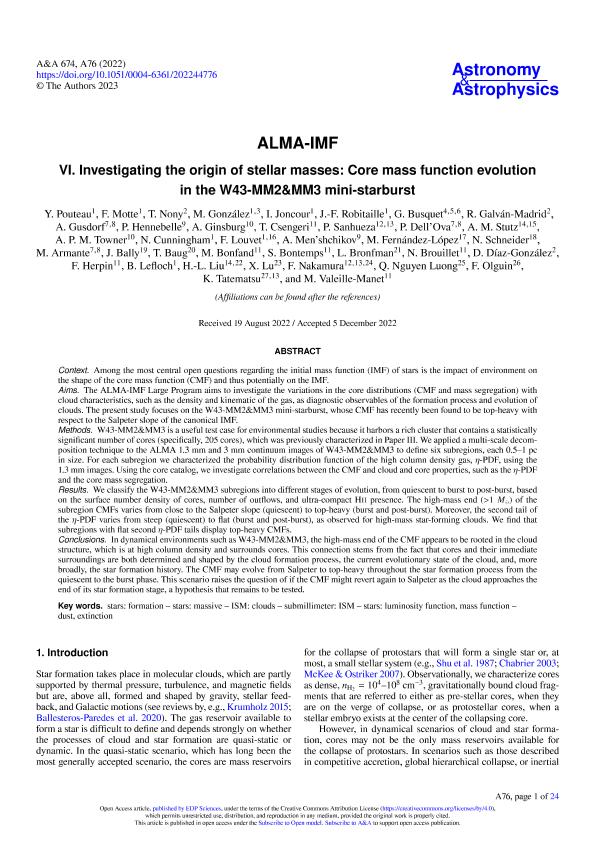Artículo
ALMA-IMF. VI : investigating the origin of stellar masses: Core mass function evolution in the W43-MM2&MM3 mini-starburst
Pouteau, Y.; Motte, F.; Nony, T.; González, M.; Joncour, I.; Robitaille, J.-F.; Busquet, G.; Galván Madrid, R.; Gusdorf, A.; Hennebelle, P.; Ginsburg, A.; Csengeri, T.; Sanhueza, P.; Dell'Ova, P.; Stutz, A. M.; Towner, A. P. M.; Cunningham, N.; Louvet, F.; Men?shchikov, A.; Fernandez Lopez, Manuel ; Schneider, N.; Armante, M.; Bally, J.; Baug, T.; Bonfand, M.; Bontemps, S.; Bronfman, L.; Brouillet, N.; Díaz-González, D.; Herpin, F.; Lefloch, B.; Liu, H.-L.; Lu, X.; Nakamura, F.; Luong, Q. Nguyen; Olguin, F.; Tatematsu, K.; Valeille Manet, M.
; Schneider, N.; Armante, M.; Bally, J.; Baug, T.; Bonfand, M.; Bontemps, S.; Bronfman, L.; Brouillet, N.; Díaz-González, D.; Herpin, F.; Lefloch, B.; Liu, H.-L.; Lu, X.; Nakamura, F.; Luong, Q. Nguyen; Olguin, F.; Tatematsu, K.; Valeille Manet, M.
 ; Schneider, N.; Armante, M.; Bally, J.; Baug, T.; Bonfand, M.; Bontemps, S.; Bronfman, L.; Brouillet, N.; Díaz-González, D.; Herpin, F.; Lefloch, B.; Liu, H.-L.; Lu, X.; Nakamura, F.; Luong, Q. Nguyen; Olguin, F.; Tatematsu, K.; Valeille Manet, M.
; Schneider, N.; Armante, M.; Bally, J.; Baug, T.; Bonfand, M.; Bontemps, S.; Bronfman, L.; Brouillet, N.; Díaz-González, D.; Herpin, F.; Lefloch, B.; Liu, H.-L.; Lu, X.; Nakamura, F.; Luong, Q. Nguyen; Olguin, F.; Tatematsu, K.; Valeille Manet, M.
Fecha de publicación:
06/2023
Editorial:
EDP Sciences
Revista:
Astronomy and Astrophysics
ISSN:
0004-6361
Idioma:
Inglés
Tipo de recurso:
Artículo publicado
Clasificación temática:
Resumen
Context. Among the most central open questions regarding the initial mass function (IMF) of stars is the impact of environment on the shape of the core mass function (CMF) and thus potentially on the IMF.Aims: The ALMA-IMF Large Program aims to investigate the variations in the core distributions (CMF and mass segregation) with cloud characteristics, such as the density and kinematic of the gas, as diagnostic observables of the formation process and evolution of clouds. The present study focuses on the W43-MM2&MM3 mini-starburst, whose CMF has recently been found to be top-heavy with respect to the Salpeter slope of the canonical IMF.Methods: W43-MM2&MM3 is a useful test case for environmental studies because it harbors a rich cluster that contains a statistically significant number of cores (specifically, 205 cores), which was previously characterized in Paper III. We applied a multi-scale decomposition technique to the ALMA 1.3 mm and 3 mm continuum images of W43-MM2&MM3 to define six subregions, each 0.5-1 pc in size. For each subregion we characterized the probability distribution function of the high column density gas, η-PDF, using the 1.3 mm images. Using the core catalog, we investigate correlations between the CMF and cloud and core properties, such as the η-PDF and the core mass segregation.Results: We classify the W43-MM2&MM3 subregions into different stages of evolution, from quiescent to burst to post-burst, based on the surface number density of cores, number of outflows, and ultra-compact HII presence. The high-mass end (>1 M⊙) of the subregion CMFs varies from close to the Salpeter slope (quiescent) to top-heavy (burst and post-burst). Moreover, the second tail of the η-PDF varies from steep (quiescent) to flat (burst and post-burst), as observed for high-mass star-forming clouds. We find that subregions with flat second η-PDF tails display top-heavy CMFs.Conclusions: In dynamical environments such as W43-MM2&MM3, the high-mass end of the CMF appears to be rooted in the cloud structure, which is at high column density and surrounds cores. This connection stems from the fact that cores and their immediate surroundings are both determined and shaped by the cloud formation process, the current evolutionary state of the cloud, and, more broadly, the star formation history. The CMF may evolve from Salpeter to top-heavy throughout the star formation process from the quiescent to the burst phase. This scenario raises the question of if the CMF might revert again to Salpeter as the cloud approaches the end of its star formation stage, a hypothesis that remains to be tested.
Palabras clave:
stars: formation
,
stars: massive
,
ISM: clouds
,
submillimeter: ISM
Archivos asociados
Licencia
Identificadores
Colecciones
Articulos(IAR)
Articulos de INST.ARG.DE RADIOASTRONOMIA (I)
Articulos de INST.ARG.DE RADIOASTRONOMIA (I)
Citación
Pouteau, Y.; Motte, F.; Nony, T.; González, M.; Joncour, I.; et al.; ALMA-IMF. VI : investigating the origin of stellar masses: Core mass function evolution in the W43-MM2&MM3 mini-starburst; EDP Sciences; Astronomy and Astrophysics; 674; 6-2023
Compartir
Altmétricas



